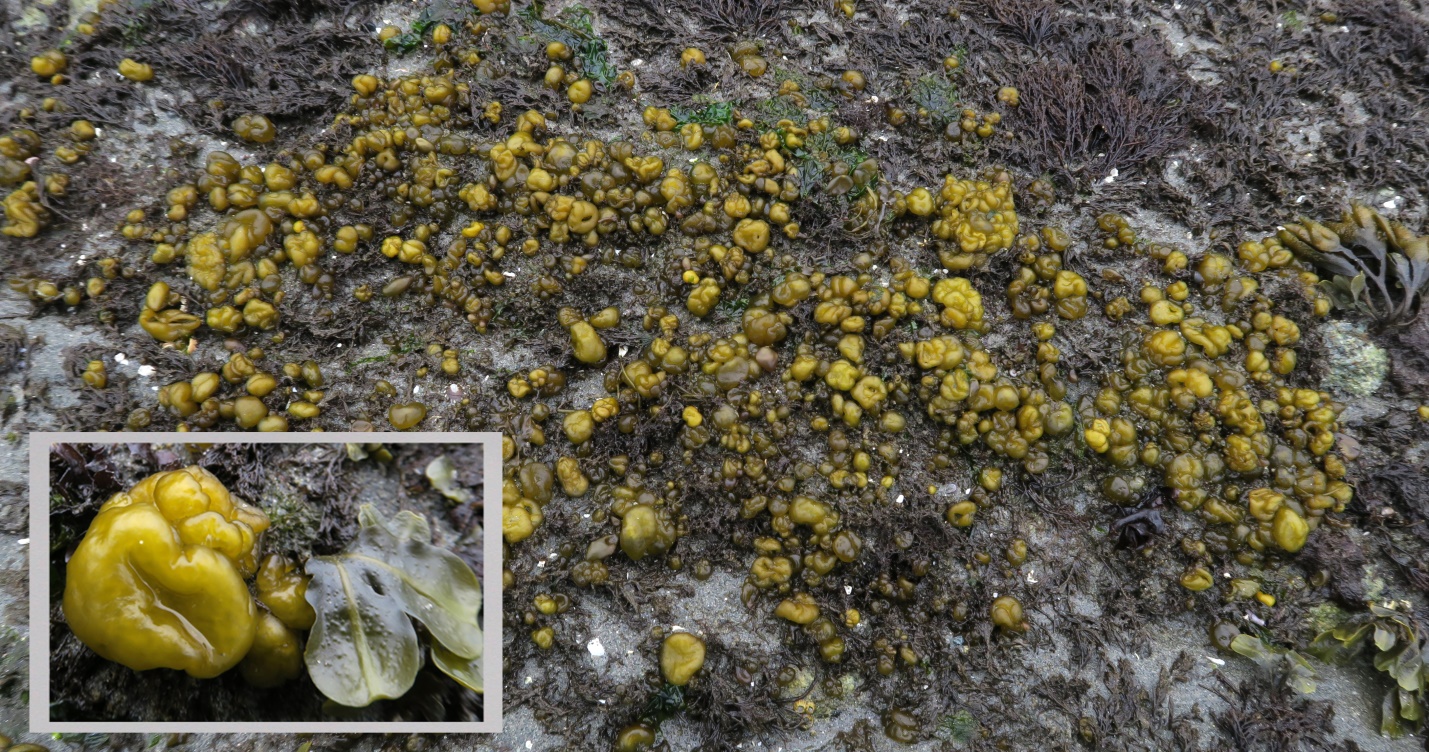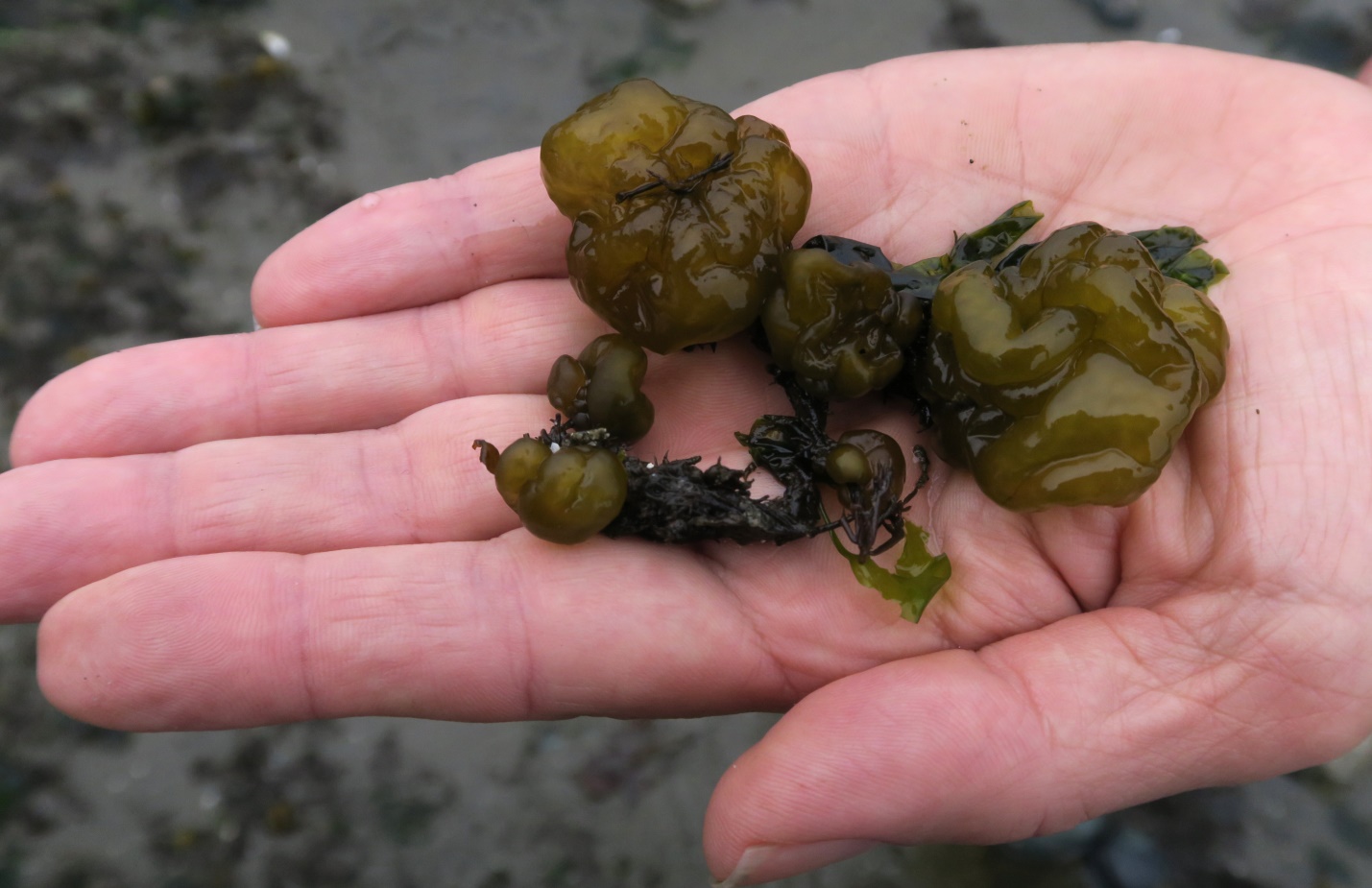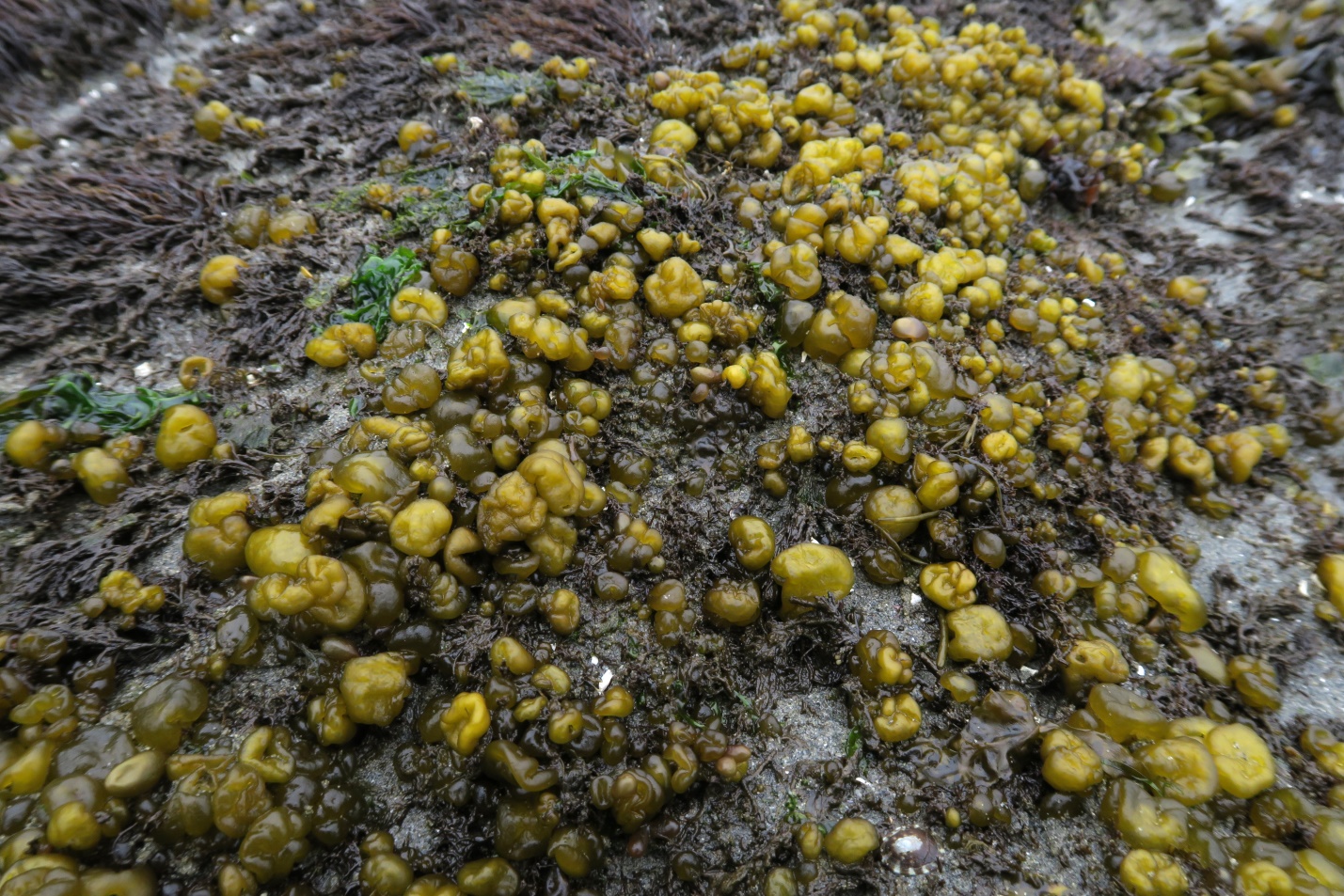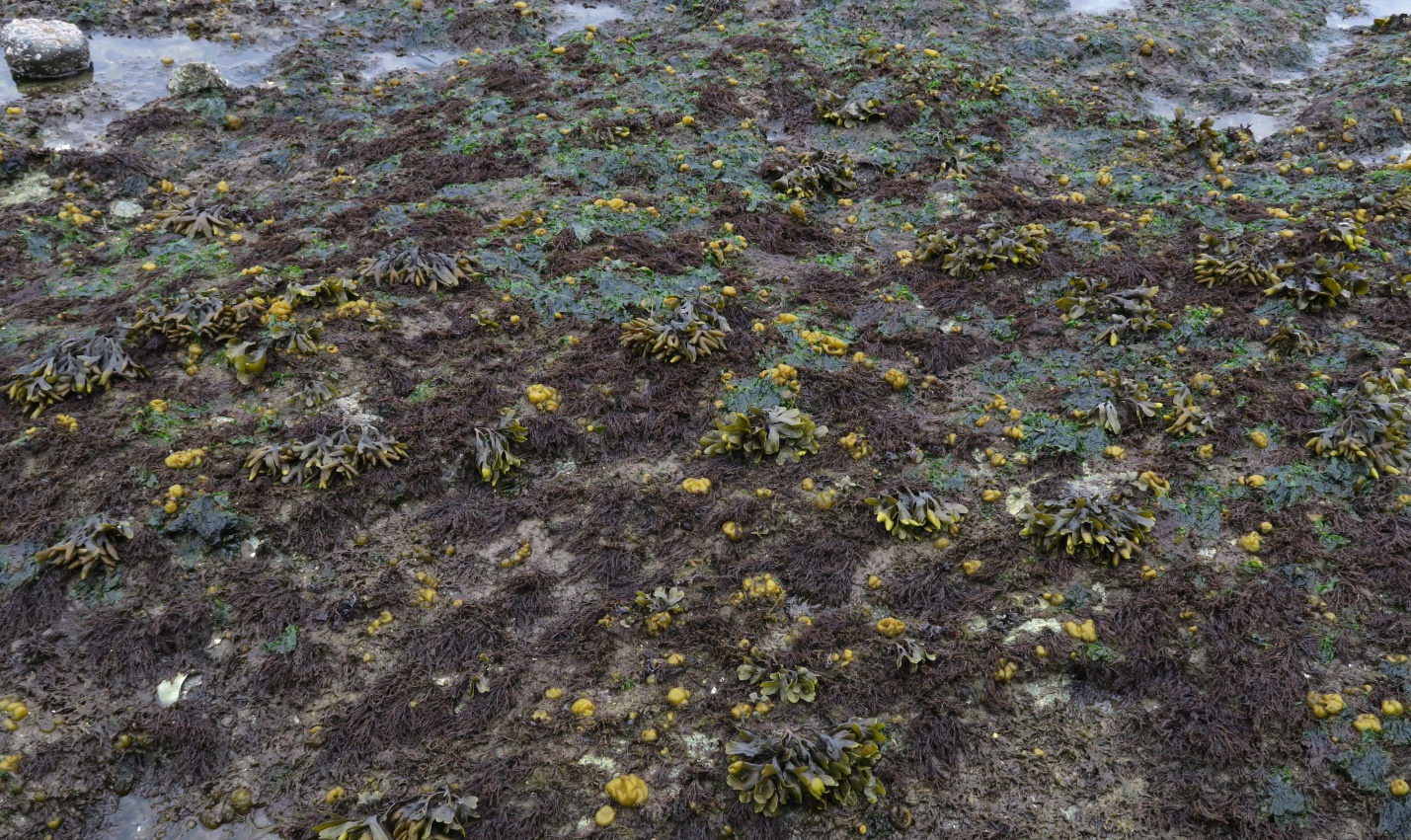
Leathesia marina
Sea Cauliflower
Bazan Bay, Haro Strait, British Columbia, Canada
24 April 2020
Collected at 12:45 pm PDT
Low
Tide 2.6 feet at 12:20pm PDT (measured at Sidney Tidal
Station)
Weather: High overcast skies, calm seas, no swell, no
wind, temperature 13˚, relative humidity 83%.
Phase of Moon: Waxing Crescent (Previous Phase, New Moon, 22 Apr 2020 7:25pm PDT; Next Phase, First Quarter, 30 Apr 2020 1:38pm)

Figure 1: Leathesia marina, a ‘carpet’ of Sea Cauliflower at Bazan Bay; (inset) shows closer view of three individual ‘cauliflowers’ and a few young Fucus distichus fronds; Haro Strait, BC, Canada. April 24, 2020. Photo ID 27148 ©Seaweedwhisperings.com
In situ observations:
Person 1:
Brain, looks like.
Many faces.
Ugly.
Interesting, but doesn’t attract me.
Plopped in place.
Like jellied candy jujubes.
Looks smooth but not slimy.
Attachment traps other seaweeds.
Pleasant smooth feel.
Bounces back to shape after being squeezed.
Pops when pressed hard. I had no urge to keep popping.
Androgynous.
Completely exposed in a sheltered environment (in a bay not exposed to crashing surf).
Person 2:
Popping up, proliferating on your bedrock/high point of the sandy beach.
So many!!!
Shapes so varied – no two the same?
Looks like some kind of tumor or adipose tissue.
Bright yellow-green.
You seem un-phased by the tide being out, by being exposed.
Looks hollow. Touch to find out: yes, you depress easily and bounce back to shape easily.
Slippery to touch but not slimy.
Slippery and sort of smooth, but I feel a surface textured as if by many tiny round knobs.
I doubt your shape changes whether submerged or exposed.
Thousands of you in this one area (5 meters by 11 meters) – and so many tiny ones coming still (not in that count).
Seasonality?
New growth now, late April?
Observations, during harvest & preparing to transport from seashore, leaving the seashore and transporting to home site:
Person 1:
They float – any orientation.
Person 2:
Pulling on cauliflowers and they break or crack – decide to cut them from their perch.
Adipose – fat tissue; do you “store” something – are hollow compartments to hold/encapsulate something?
Detached and in water they float.
Need to be anchored!!!
White-fronted Geese flew overhead heading north to breeding grounds – the season of next generations.
Getting into the vehicle so I could cradle seaweed buckets between my legs/feet, cramp felt in left foot.
Driving back, kink in right side of my neck. I had been holding my head cocked at an old angle for some reason. Also sat crooked in my seat.
Odd angels, crunched – no reason I needed to be cramped or crunched.
Didn’t notice I was crunching/cramping (until I felt pain).

Figure 2: A few Sea Cauliflower ‘individuals’ of varying sizes and some of the other macro algae they affix to/live in community with. Bazan Bay, Haro Strait, BC, Canada. April 24, 2020. Photo ID 27149 ©Seaweedwhisperings.com
Observations & Impressions (seaweed samples in basin of seawater):
Person 1:
Floating jellyfish.
Blob.
Moves easily on water surface, but can spin comfortably only two dimensionally (horizontal). Awkward in any other movement.
Somewhat translucent.
Bounces resiliently to the surface after being pushed down in water.
When on its back, looks curled in a fetal position. Noticed this more and more as I looked more.
Has the feel to me of parchment.
Easy to grip.
Squeaky, frog like sounds when squeezed.
Pleasantly smooth when rubbed on face.
Distinctly iodine smell.
Taste nondescript.
Got slight burning sensation in both cheek bones (felt deeper than skin).
Sand embedded in tissue?
Dried up mouth, tingling in upper lip after about 10 minutes.
“Leathesia” – imagined a taxonomist naming this odd-shaped seaweed after a scientist he didn’t like.
“Marina” – pleasant visions of a tropical (Western Mexico) seashore.
Sea Cauliflower – distinctive but nondescript name.
Person 2:
Look like tumor masses and prolific, cancerous?
Each rounded blob of Sea Cauliflower has differing indentations, puckers, smoother extending bulbous parts – no two alike!
What do all those crevices/indentations give you? A way to hold water? Otherwise, why not just be a big sphere?
Knobby, finely pebbled texture to the bulbous surface except on the very young/smallest ones.
While testing this difference, my small blob broke into two parts.
Detached and floating on the water – feeling distressed, alarmed. This isn’t good.
Where will I end up?
Adrift on the wide ocean…?
Inside surface of the irregular blob has a texture that looks like velvet or fine suede leather. Outside surface looks like and has the light reflecting/absorbing qualities of the patina of full-grained leather.
Tempting to touch, to squeeze, to see what happens when I do.
Gentle touch – cauliflower springs back.
Hard touch – and the cauliflower blob cracks, tears apart, but the “skin” doesn’t crush – it’s tough almost like thin, somewhat rubbery leather.
Inside surface, to touch is very soft.
Fresh – like faint smell of junipers on a warm day. I love the smell.
Smell dissipates – did I squeeze it out of your hollow storage pockets?
A gas now dispersed – a memory only lingers?
Gritty – sand inside.
Very salty taste.
Need water after tasting, salty effect.
Tongue dry feeling and lingering tingling after about 10 to 15 minutes on tongue, upper palate and lips.
Species name, “marina”, – of the sea.
“Leathesia” – sounds like a female name, not masculine at all.
Leath – add ‘er’ then you have “leather”; leather was a word that felt right in my “look” descriptions.
Sea Cauliflower – grows at the seashore, and the blobs of contorted rounded shapes do roughly resemble cauliflower florets. Yellow-green of this seaweed is bright – stands out from the Fucus and other nearby seaweeds like yellow brassica (cauliflower plant family) flowers – they are also strikingly bright, even vivid yellow, against their background.

Figure 3: Clusters of Leathesia marina – variations and contortions galore. Bazan Bay, Haro Straight, BC, Canada. April 24, 2020. Photo ID 27150 ©Seaweedwhisperings.com
Further Observations & Impressions:
Person 1:
Leave the past behind.
Worry about sensations – hypochondria?
Numb to criticism – it rolls off my smoothness like a passing wave.
Hangs on to beliefs, but lost and cast adrift when beliefs are shattered.
Became unusually and extremely sleepy – almost fell asleep, despite having adequate food and water and sleep.
Person 2:
Happy as a group.
Bumping shoulders, that’s OK – I’ll just blob out over here, too.
Don’t want to move.
Likes to stay in place – feels right.
When whole, water and surf rolls over, brings pleasure.
If someone steps on me or a log hits me, my whole is breeched, water now is a danger, will rip me asunder.
Being “whole” matters – life or death, parted from what I know.
Good at contortions – yet I still am seen as just a blob. That’s OK – my character is safely hidden, my personality contained inside.
Don’t want to lose home.
Homesick thoughts, I tumble inward.
No reaching out, floating or waving around in the surf – that’s too risky.
Risks what?
Everything!
Everything I know – my neighbours, my orientation, my food and sunshine.
I like what I know.
It comforts me.
Plans, planning for tomorrow, that doesn’t interest me – plans are set aside, no promises to keep nor ambitions to pursue.
Suddenly felt, “that’s it” (abruptly jumped out of my receiving/observing state).
Discussion:
Both persons felt indecision about which seaweed or cluster of seaweeds to choose to interact with. Almost like it was hard to hold on to a distinguishing feature and therefore determine a preference.
Individual plants were hard to choose amongst.
We also had a hard time choosing where to sit to observe the seaweed in situ.
Person 1 had stated he had no strong affinity to this seaweed right from the start of his interactions and this continued throughout.
Person 2 wanted to estimate the number of cauliflowers in this “patch”. After the estimate was made, Person 2 observed many more tiny new cauliflowerlets and thought, “oh look, we missed so many of them”. Then wanted a recount.
When the collection was happening Person 2 wanted more specimens than originally decided upon and specifically wanted a few ‘baby’/very small individuals.
“More” seemed significant.
The more of us there are, the more I become an indistinguishable blob, and I just blend in. I am comfortable when I blend in. No one then knows me as being any different from all my other blob neighbours.
It’s not that I want more possessions, more friends, more beer, more to eat; the concept of “more” is about safety in numbers. In the group, no one blob can be identified to take any blame, also no one blob can be identified as a star.
No “one” is singled out.
No “one” needs to explore or “own” his/her own interior self.
I’m in the open – exposed, but also protected by my friends. We’re all “of the same” group, we can say what we want and are not afraid to do so with each other.
If you get separated from your group, your group won’t notice that you’re gone, but you dearly suffer the loss of your group, because now you’re distinguishable – you’re no longer safe and contentedly being “just one of the blobs”.
Everything’s OK if in own group – if not, everything goes wrong.
Everything is very not OK – one feels lost and cast adrift, if betrayed or beliefs are shattered. Everything “known” is lost. Like the world has tipped on its axis, disorienting because it forces reassessment, a new understanding of self – that is TOO MUCH to fathom. Therefore, stay anchored!!!

Figure 4: An expanse of the beach populated with a diversity of macro algae and studded with blobs of golden/yellow-green Sea Cauliflower. Bazan Bay, Haro Strait, BC, Canada. April 24, 2020. Photo ID 27151 ©Seaweedwhisperings.com
Biology & Natural History Information:
Description:
This plant is spherical and solid when young, becoming irregularly and deeply convoluted, hollow and broadly expanded as it matures. It is spongy in texture, yellowish brown/green in color and sizes range from 1 – 6cm in diameter, although may become larger (up to 12cm) as they grow into each other. Where found it is often abundant, forming a low lying peculiar looking bubbly/bumpy carpet in the intertidal zone. This annual species appears in early spring; look for it later in the fall and there will be not a sign of it.
The medulla is composed of colourless, free branched filaments of large cells; the cells are progressively smaller and compacted near the surface, and free assimilating filaments and long colourless hairs project beyond the surface. When squeezed between your fingers Leathesia tends to disintegrate; this distinguishes it from other globular and cushiony seaweeds like Colpomenia and Soranthera.
Habitat: This annual species can be found on rock or as an epiphyte (growing on other species of algae with no harm to that species) in all intertidal zones from protected to semi-exposed habitats.
World Distribution: Bering Sea, Unalaska I., Alaska to Baja California, Mexico; Chile; western North Pacific; North Atlantic; North Sea; China; Korea; Japan; Russia.
Remarks: When this species was first described by the famous botanist Carolus Linnaeus, the unusual shape of this alga led him to believe it was a jelly fungus (originally identified as belonging to a totally different kingdom than plants, green & algae, and brown algae) – hence the early name. The genus name, Leathesia, is named for a British naturalist, Reverend G.R Leathes.
Classification:
Class: Phaeophyceae
Order: Ectocarpales
Family: Chordariaceae
Genus: Leathesia
Species: Leathesia marina (Lyngbye) Decaisne 1842
Former Scientific Names: Chaetophora marina, Tremella difformis, Leathesia difformis.
Other Common names: cauliflower seaweed, brain seaweed, golden spongy cushion, punctured ball weed, sea potato.
![]()